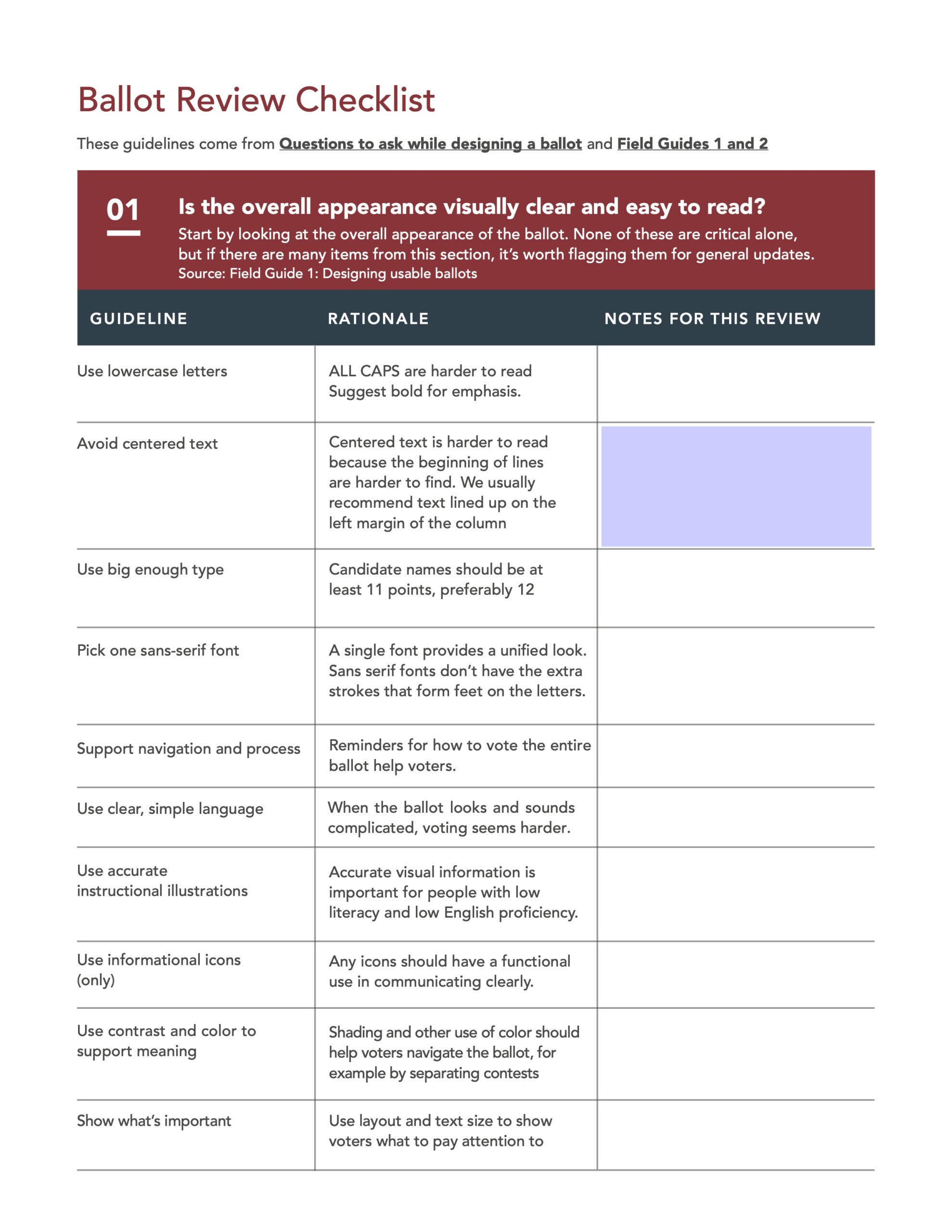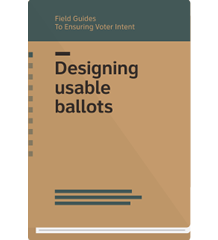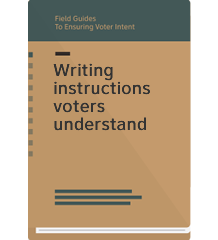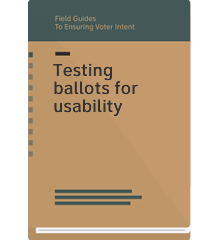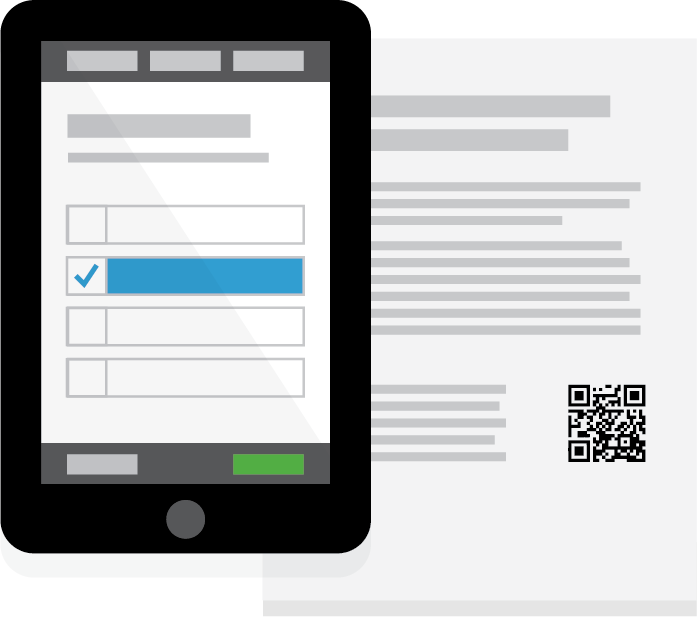Ballot design
Ballots that can be marked privately and independently are at the heart of the voter journey.
Ballot design is hard because there are so many constraints —legislation, voting systems, language requirements, and litigation for hundreds of different ballot styles that have to be designed in the few weeks between the end of candidate filing and sending the first ballots to overseas voters.
Center for Civic Design’s work started even before the organization was official, working on ballot design in the years following the butterfly ballots of the 2000 presidential election. Our first best practices in the Field Guides to Ensure Voter Intent are about ballot design and instructions. Those guidelines are still important today.
We’ve seen that well-designed ballots give voters confidence. And that ballots can fool voters into overvoting (so their vote in that contest doesn’t count) or undervoting (missing an opportunity to make a choice) when they have design defects.
Tools
Ballot design subtopics
Ballot design tips
Articles on detailed topics in ballot design with tips and recommendations
- Put navigation instructions where voters need them
- Typography makes ballots easy to read
- Breaking the ballot: 34 candidates for Senate
- Text on the left or right – which works better?
- Solving the double vote problem in New York through design
- Instructions on vote-by-mail ballot stubs build confidences in Arapahoe County
- Testing ballots: Real names or fictional? Direct how to vote or not?
Ballot design standards
- Don’t legislate ballot design (there’s a better way to improve ballots)
- Ballots are made by laws and systems – and miracle workers
- Usability matters, even with paper ballots
- Why is it so hard to produce a usable, well-designed ballot?
- Example from the field: Updated ballot standards for Virginia
Examples from the field
- A better ballot for New York State
A design concept ballot for “full-face” ballots. - Participating in Participatory Budgeting
A report on usability testing ballots in New York City
Ballot marking devices
Ballot questions
- Ballot questions are hard to understand. Here are 6 ways to fix them.
- Context is key for explaining ballot questions in voter guides
- Voter guide page sample: Ballot questions
Words to time calculator: A free online tool to get a reading time estimate based on word count and slow, average and fast reading speed. We used this calculator to determine an estimate of how long it would take to read 1,000 words on a ballot.
Provisional ballots
- You see a provisional ballot, voters see their ballot
A look at the process of casting a provisional ballot - Making provisional voting easier in Virginia
A redesign example - An updated provisional ballot form for Ohio
Before and after following a law change
Voter verification
Press
- Good design is the secret to better democracy (Ballots are broken. We redesigned them.) – NY Times Visual Opinion (2020)
- Why it’s so hard to fix America’s poorly-designed election ballot – Quartz (2020)
- How to beat bad ballot design and make sure your vote counts – Washington Post (2020)
- How a bad ballot design can sway the result of an election – The Guardian (2019)
- How a badly designed ballot might have swayed the election in Florida – Washington Post (2018)
- Why Are So Many Election Ballots Confusing? – NPR’s All Things Considered (2018)
Our work
Toolkit: Guidance for usability testing ballots and voting systems
These guidance documents and the accompanying sample materials and templates, support usability testing with voters and with poll workers.
Toolkit: The usability of electronic poll books
This 2014 project looked at the electronic poll books being used in elections and how to make them usable. The report includes:
- A checklist for usability and accessibility
- A usability test plan
- Landscape analysis of systems
Project: Anywhere ballot: What if anyone could vote on any device
Design research for a universal electronic ballot marking interface that every voter can use. Includes:
- Anywhere Ballot Design Principles and Design pattern library
- Research papers and presentations
- Video of research to the Presidential Commission on Election Administration
- Bibliography of articles on assistive technology
- Links to examples of voting systems using Anywhere Ballot principles
Research: Voter verification of paper ballots
A two-part report that included qualitative research project to gain deeper insights into how voters mark, review, verify, and cast their ballots. It looked at the role the design of the voting interaction and overall voting process plays in encouraging voters to carefully check their ballot before casting it and a review of the literature. (Pre-publication versions of report for NIST)
- Literature review: Voter review and verification of paper ballots
- Research report: How voters review & verify ballots from ballot marking devices
Research: Legibility of paper ballots: What makes a printed summary-style ballot easy to verify?
An exploration of design characteristics of summary ballots and whether they are readable visually and with optical scan recognition (OCR) tools for accessibility. (Pre-publication version of a report for NIST)
Research: Developing voting system requirements for VVSG 2.0
The roadmap for this work along with white papers and other materials from the process.
White paper: Ballot simplicity, constraints, and design literacy
There’s actually nothing simple about voting in the United States — especially interacting with ballots. This report covers the history and constraints in designing a ballot
Research from partners in the election field
The Brennan Center: Ballot design project
We have collaborated with legal and political science experts at the Brennan Center since 2008. Research reports include analysis of election data and recommendations for how to fix them. Major reports we have contributed to include:
- Better Ballots (2008)
- Design Deficiencies and Lost Votes (2011)
- Better Design: Better Elections (2012)
- Common Ballot Design Flaws and How to Fix Them (2020)
The Election Assistance Commission
- Designing polling place materials
Guidelines, resources, and the full report on ballot design in Effective Designs for the Administration of Federal Elections - Voluntary Voting System Guidelines
Requirements for voting systems including usability and accessibility


